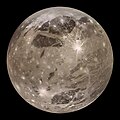Ganymede (moon)
Ganymede[p] is the largest of the 95 known moons of the planet Jupiter. It is also the largest moon in the Solar System. Ganymede is larger in diameter than the planet Mercury, but has only about half of its mass as Ganymede is much less dense. Ganymede is part of a group called the Galilean Satellites. These also include Io, Europa and Callisto.
 Click image for description | |
| Discovery | |
|---|---|
| Discovered by | G. Galilei S. Marius |
| Discovery date | January 11, 1610 |
| Orbital characteristics | |
| Periapsis | 1,069,200 km (0.007147 AU) |
| Apoapsis | 1,071,600 km (0.007163 AU) |
Mean orbit radius | 1,070,400 km (0.007155 AU) |
| Eccentricity | 0.002[1] |
| 7.15455296 d (0.019588 a) | |
Average orbital speed | 10.880 km/s |
| Inclination | 2.21° (to the ecliptic) 0.20° (to Jupiter's equator) |
| Satellite of | Jupiter |
| Physical characteristics | |
Mean radius | 2631.2 km (0.413 Earths) |
| 87.0 million km² (0.171 Earths) [2] | |
| Volume | 7.6×1010 km³ (0.0704 Earths) |
| Mass | 1.4819×1023 kg (0.025 Earths) |
Mean density | 1.942 g/cm³ |
| 1.428 m/s2 (0.146 g) | |
| 2.741 km/s (6,130 mph) | |
| synchronous | |
| zero | |
| Albedo | 0.43 ± 0.02[3] |
| Temperature | ~109 K (−172 °C) |
| 4.61 (opposition) [3] | |
| Atmosphere | |
Surface pressure | trace |
| Composition by volume | oxygen |
Galileo Galilei discovered this moon in 1610.[4] Simon Marius suggested the name "Ganymede" soon after. In Greek mythology, Ganymede was Zeus' cup-bearer.[5] This name and the names of the other Galilean satellites were not favoured for a long time, and were not put into common use until the mid-20th century. Instead, it is simply referred to by its Roman numeral designation (a system that was introduced by Galileo) as "Jupiter III" or as the "third satellite of Jupiter".[6] Ganymede is the only Galilean moon of Jupiter named after a male figure.
Structure
Ganymede is composed of roughly equal amounts of silicate rock and water ice.[7] Its body has an iron-rich, liquid core, and an internal ocean that may contain more water than all of Earth's oceans together.[8][9][10][11][12] Its surface has dark regions, with impact craters dated to four billion years ago. This covers about a third of the satellite. Lighter regions, crosscut by grooves and ridges and only slightly less ancient, cover the rest. The cause of the light terrain's disrupted geology is not fully known, but was likely the result of tectonic activity caused by tidal heating.[13] Ganymede is also the only known moon to have a magnetic field of its own.[14]
Ganymede (moon) Media
Notes
- [p] ^ The name "Ganymede" is said as /Gan-ee-Meed/.
References
- ↑ "Ganymede: Facts and Figures". Solar System Exploration. Archived from the original on 2007-08-08. Retrieved 2007-12-07.
- ↑ Using the mean radius
- ↑ 3.0 3.1 Yeomans, Donald K. (2006-07-13). "Planetary Satellite Physical Parameters". JPL Solar System Dynamics. Retrieved 2007-11-05.
- ↑ Galilei, G.; Sidereus Nuncius Archived 2009-08-23 at the Wayback Machine (March 13, 1610)
- ↑ Marius, S.; (1614); Mundus Iovialis anno M.DC.IX Detectus Ope Perspicilli Belgici [1], where he attributes the suggestion to Johannes Kepler
- ↑ "Satellites of Jupiter". The Galileo Project. Retrieved 2007-11-24.
- ↑ Chang, Kenneth (March 12, 2015). "Suddenly, it seems, water is everywhere in Solar System". New York Times. https://www.nytimes.com/2015/03/13/science/space/suddenly-it-seems-water-is-everywhere-in-solar-system.html. Retrieved March 12, 2015.
- ↑ Staff (March 12, 2015). "NASA's Hubble observations suggest underground ocean on Jupiter's largest moon". NASA News. http://www.nasa.gov/press/2015/march/nasa-s-hubble-observations-suggest-underground-ocean-on-jupiters-largest-moon/#.VQJhMM26t0s. Retrieved 2015-03-15.
- ↑ "Jupiter moon Ganymede could have ocean with more water than Earth – NASA". Russia Today (RT). 13 March 2015. http://rt.com/usa/240301-nasa-jupiter-ganymede-ocean. Retrieved 2015-03-13.
- ↑ Clavin, Whitney (1 May 2014). "Ganymede may harbor 'club sandwich' of oceans and ice". NASA (Jet Propulsion Laboratory). http://www.jpl.nasa.gov/news/news.php?release=2014-138. Retrieved 2014-05-01.
- ↑ Vance, Steve; Bouffard, Mathieu; Choukroun, Mathieu; Sotina, Christophe (12 April 2014). "Ganymede's internal structure including thermodynamics of magnesium sulfate oceans in contact with ice". Planetary and Space Science. 96: 62. Bibcode:2014P&SS...96...62V. doi:10.1016/j.pss.2014.03.011. Retrieved 2014-05-02.
- ↑ Staff (1 May 2014). "Video (00:51) - Jupiter's 'Club Sandwich' Moon". NASA. Retrieved 2014-05-02.
- ↑ Tidal heating: the huge force of Jupiter's gravitation deforms the satellite as it swings round its orbit. The orbit is not circular, and this sets up the stresses which cause the tectonic activity.
- ↑ "Ganymede: Facts". science.nasa.gov. Archived from the original on 2024-04-15. Retrieved 2024-04-04.
Other websites
- Ganymede Archived 2011-05-20 at the Wayback Machine









